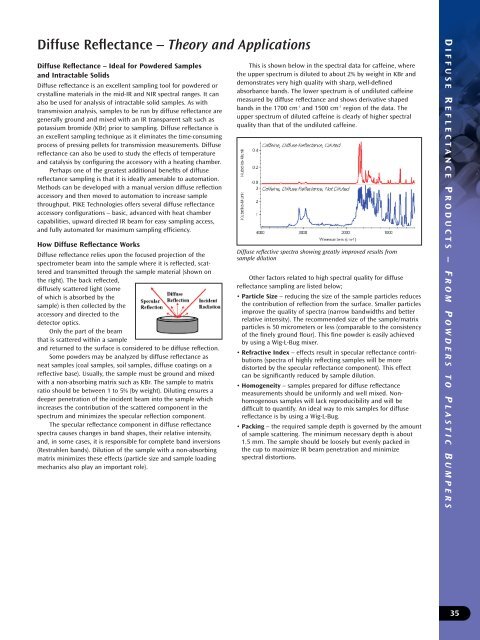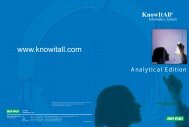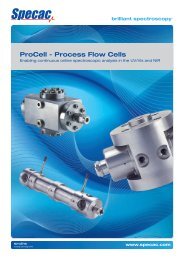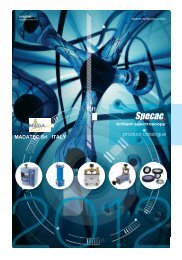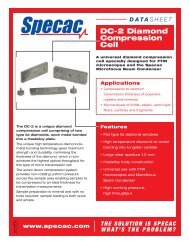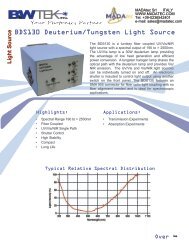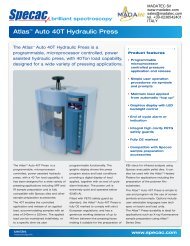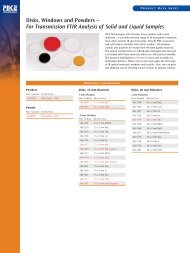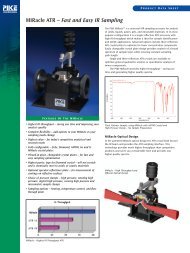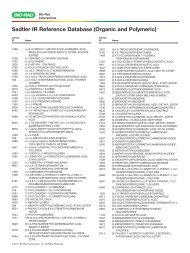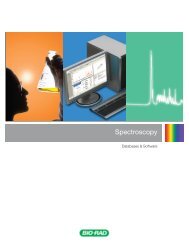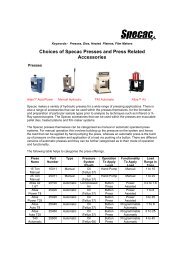Pike Technologies Comprehensive Catalog of FTIR ... - Madatec
Pike Technologies Comprehensive Catalog of FTIR ... - Madatec
Pike Technologies Comprehensive Catalog of FTIR ... - Madatec
You also want an ePaper? Increase the reach of your titles
YUMPU automatically turns print PDFs into web optimized ePapers that Google loves.
Diffuse Reflectance – Theory and Applications<br />
Diffuse Reflectance – Ideal for Powdered Samples<br />
and Intractable Solids<br />
Diffuse reflectance is an excellent sampling tool for powdered or<br />
crystalline materials in the mid-IR and NIR spectral ranges. It can<br />
also be used for analysis <strong>of</strong> intractable solid samples. As with<br />
transmission analysis, samples to be run by diffuse reflectance are<br />
generally ground and mixed with an IR transparent salt such as<br />
potassium bromide (KBr) prior to sampling. Diffuse reflectance is<br />
an excellent sampling technique as it eliminates the time-consuming<br />
process <strong>of</strong> pressing pellets for transmission measurements. Diffuse<br />
reflectance can also be used to study the effects <strong>of</strong> temperature<br />
and catalysis by configuring the accessory with a heating chamber.<br />
Perhaps one <strong>of</strong> the greatest additional benefits <strong>of</strong> diffuse<br />
reflectance sampling is that it is ideally amenable to automation.<br />
Methods can be developed with a manual version diffuse reflection<br />
accessory and then moved to automation to increase sample<br />
throughput. PIKE <strong>Technologies</strong> <strong>of</strong>fers several diffuse reflectance<br />
accessory configurations – basic, advanced with heat chamber<br />
capabilities, upward directed IR beam for easy sampling access,<br />
and fully automated for maximum sampling efficiency.<br />
How Diffuse Reflectance Works<br />
Diffuse reflectance relies upon the focused projection <strong>of</strong> the<br />
spectrometer beam into the sample where it is reflected, scattered<br />
and transmitted through the sample material (shown on<br />
the right). The back reflected,<br />
diffusely scattered light (some<br />
<strong>of</strong> which is absorbed by the<br />
sample) is then collected by the<br />
accessory and directed to the<br />
detector optics.<br />
Only the part <strong>of</strong> the beam<br />
that is scattered within a sample<br />
and returned to the surface is considered to be diffuse reflection.<br />
Some powders may be analyzed by diffuse reflectance as<br />
neat samples (coal samples, soil samples, diffuse coatings on a<br />
reflective base). Usually, the sample must be ground and mixed<br />
with a non-absorbing matrix such as KBr. The sample to matrix<br />
ratio should be between 1 to 5% (by weight). Diluting ensures a<br />
deeper penetration <strong>of</strong> the incident beam into the sample which<br />
increases the contribution <strong>of</strong> the scattered component in the<br />
spectrum and minimizes the specular reflection component.<br />
The specular reflectance component in diffuse reflectance<br />
spectra causes changes in band shapes, their relative intensity,<br />
and, in some cases, it is responsible for complete band inversions<br />
(Restrahlen bands). Dilution <strong>of</strong> the sample with a non-absorbing<br />
matrix minimizes these effects (particle size and sample loading<br />
mechanics also play an important role).<br />
This is shown below in the spectral data for caffeine, where<br />
the upper spectrum is diluted to about 2% by weight in KBr and<br />
demonstrates very high quality with sharp, well-defined<br />
absorbance bands. The lower spectrum is <strong>of</strong> undiluted caffeine<br />
measured by diffuse reflectance and shows derivative shaped<br />
bands in the 1700 cm -1 and 1500 cm -1 region <strong>of</strong> the data. The<br />
upper spectrum <strong>of</strong> diluted caffeine is clearly <strong>of</strong> higher spectral<br />
quality than that <strong>of</strong> the undiluted caffeine.<br />
Diffuse reflective spectra showing greatly improved results from<br />
sample dilution<br />
Other factors related to high spectral quality for diffuse<br />
reflectance sampling are listed below;<br />
• Particle Size – reducing the size <strong>of</strong> the sample particles reduces<br />
the contribution <strong>of</strong> reflection from the surface. Smaller particles<br />
improve the quality <strong>of</strong> spectra (narrow bandwidths and better<br />
relative intensity). The recommended size <strong>of</strong> the sample/matrix<br />
particles is 50 micrometers or less (comparable to the consistency<br />
<strong>of</strong> the finely ground flour). This fine powder is easily achieved<br />
by using a Wig-L-Bug mixer.<br />
• Refractive Index – effects result in specular reflectance contributions<br />
(spectra <strong>of</strong> highly reflecting samples will be more<br />
distorted by the specular reflectance component). This effect<br />
can be significantly reduced by sample dilution.<br />
• Homogeneity – samples prepared for diffuse reflectance<br />
measurements should be uniformly and well mixed. Nonhomogenous<br />
samples will lack reproducibility and will be<br />
difficult to quantify. An ideal way to mix samples for diffuse<br />
reflectance is by using a Wig-L-Bug.<br />
• Packing – the required sample depth is governed by the amount<br />
<strong>of</strong> sample scattering. The minimum necessary depth is about<br />
1.5 mm. The sample should be loosely but evenly packed in<br />
the cup to maximize IR beam penetration and minimize<br />
spectral distortions.<br />
D IFFUSE R EFLECTANCE P RODUCTS – F ROM P OWDERS TO P LASTIC B UMPERS<br />
35


